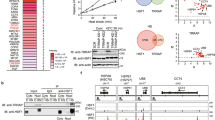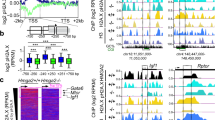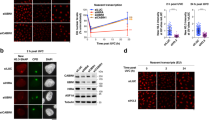Abstract
Cyclooxygenase-2 (COX-2) is an inducible enzyme that contributes to the generation of chronic inflammation in response to chemical carcinogens and environmental stresses, including ultraviolet B (UVB) irradiation. Although post-translational histone modifications are believed to have an important role in modulating transcriptional regulation of UVB-induced COX-2, the underlying biochemical mechanisms are completely unknown. Here, we show that UVB activates the p38 MAPK/MSK1 kinase cascade to phosphorylate histone H3 at Ser10 and Ser28, contributing to UVB-induced COX-2 expression. UVB has no effect on the global tri-methylation level of histone H3 (H3K4me3, H3K9me3, and H3K27me3). We observed that selected mammalian 14-3-3 proteins bind to UVB-induced phosphorylated histone H3 (Ser10 and Ser28). In particular, 14-3-3ɛ is critical for recruiting MSK1 and Cdk9 to the chromatin and subsequently phosphorylating the C-terminal domain of RNA polymerase II in the cox-2 promoter. We propose that histone H3 phosphorylation at Ser10 and Ser28 serve as critical switches to promote cox-2 gene expression by facilitating the recruitment of MSK1 and Cdk9 to the cox-2 promoter, thereby promoting RNA polymerase II phosphorylation.
This is a preview of subscription content, access via your institution
Access options
Subscribe to this journal
Receive 50 print issues and online access
$259.00 per year
only $5.18 per issue
Buy this article
- Purchase on Springer Link
- Instant access to full article PDF
Prices may be subject to local taxes which are calculated during checkout





Similar content being viewed by others
References
Wang D, Dubois RN . The role of COX-2 in intestinal inflammation and colorectal cancer. Oncogene 2009; 29: 781–788.
Rundhaug JE, Mikulec C, Pavone A, Fischer SM . A role for cyclooxygenase-2 in ultraviolet light-induced skin carcinogenesis. Mol Carcinog 2007; 46: 692–698.
Rundhaug JE, Fischer SM . Cyclo-oxygenase-2 plays a critical role in UV-induced skin carcinogenesis. Photochem Photobiol 2008; 84: 322–329.
Fernau NS, Fugmann D, Leyendecker M, Reimann K, Grether-Beck S, Galban S et al. Role of HuR and p38MAPK in ultraviolet B-induced post-transcriptional regulation of COX-2 expression in the human keratinocyte cell line HaCaT. J Biol Chem 2010; 285: 3896–3904.
Zhang J, Bowden GT . UVB irradiation regulates Cox-2 mRNA stability through AMPK and HuR in human keratinocytes. Mol Carcinog 2008; 47: 974–983.
Luger K, Mader AW, Richmond RK, Sargent DF, Richmond TJ . Crystal structure of the nucleosome core particle at 2.8 A resolution. Nature 1997; 389: 251–260.
Strahl BD, Allis CD . The language of covalent histone modifications. Nature 2000; 403: 41–45.
Allis CD, Berger SL, Cote J, Dent S, Jenuwien T, Kouzarides T et al. New nomenclature for chromatin-modifying enzymes. Cell 2007; 131: 633–636.
Kouzarides T . Chromatin modifications and their function. Cell 2007; 128: 693–705.
Cheung P, Tanner KG, Cheung WL, Sassone-Corsi P, Denu JM, Allis CD . Synergistic coupling of histone H3 phosphorylation and acetylation in response to epidermal growth factor stimulation. Mol Cell 2000; 5: 905–915.
Lo WS, Trievel RC, Rojas JR, Duggan L, Hsu JY, Allis CD et al. Phosphorylation of serine 10 in histone H3 is functionally linked in vitro and in vivo to Gcn5-mediated acetylation at lysine 14. Mol Cell 2000; 5: 917–926.
Wang GG, Allis CD, Chi P . Chromatin remodeling and cancer, Part I: covalent histone modifications. Trends Mol Med 2007; 13: 363–372.
Fischle W, Tseng BS, Dormann HL, Ueberheide BM, Garcia BA, Shabanowitz J et al. Regulation of HP1-chromatin binding by histone H3 methylation and phosphorylation. Nature 2005; 438: 1116–1122.
Hirota T, Lipp JJ, Toh BH, Peters JM . Histone H3 serine 10 phosphorylation by Aurora B causes HP1 dissociation from heterochromatin. Nature 2005; 438: 1176–1180.
Cha TL, Zhou BP, Xia W, Wu Y, Yang CC, Chen CT et al. Akt-mediated phosphorylation of EZH2 suppresses methylation of lysine 27 in histone H3. Science 2005; 310: 306–310.
Lomberk G, Bensi D, Fernandez-Zapico ME, Urrutia R . Evidence for the existence of an HP1-mediated subcode within the histone code. Nat Cell Biol 2006; 8: 407–415.
Bernstein E, Duncan EM, Masui O, Gil J, Heard E, Allis CD . Mouse polycomb proteins bind differentially to methylated histone H3 and RNA and are enriched in facultative heterochromatin. Mol Cell Biol 2006; 26: 2560–2569.
Yaffe MB . How do 14-3-3 proteins work?—Gatekeeper phosphorylation and the molecular anvil hypothesis. FEBS Lett 2002; 513: 53–57.
Macdonald N, Welburn JP, Noble ME, Nguyen A, Yaffe MB, Clynes D et al. Molecular basis for the recognition of phosphorylated and phosphoacetylated histone h3 by 14-3-3. Mol Cell 2005; 20: 199–211.
Winter S, Fischle W, Seiser C . Modulation of 14-3-3 interaction with phosphorylated histone H3 by combinatorial modification patterns. Cell Cycle 2008; 7: 1336–1342.
Egloff S, Murphy S . Cracking the RNA polymerase II CTD code. Trends Genet 2008; 24: 280–288.
Buratowski S . Progression through the RNA polymerase II CTD cycle. Mol Cell 2009; 36: 541–546.
Bachelor MA, Cooper SJ, Sikorski ET, Bowden GT . Inhibition of p38 mitogen-activated protein kinase and phosphatidylinositol 3-kinase decreases UVB-induced activator protein-1 and cyclooxygenase-2 in a SKH-1 hairless mouse model. Mol Cancer Res 2005; 3: 90–99.
Perez-Cadahia B, Drobic B, Davie JR . H3 phosphorylation: dual role in mitosis and interphase. Biochem Cell Biol 2009; 87: 695–709.
Johansen KM, Johansen J . Regulation of chromatin structure by histone H3S10 phosphorylation. Chromosome Res 2006; 14: 393–404.
Goto H, Yasui Y, Nigg EA, Inagaki M . Aurora-B phosphorylates Histone H3 at serine28 with regard to the mitotic chromosome condensation. Genes Cells 2002; 7: 11–17.
Nowak SJ, Corces VG . Phosphorylation of histone H3: a balancing act between chromosome condensation and transcriptional activation. Trends Genet 2004; 20: 214–220.
Prigent C, Dimitrov S . Phosphorylation of serine 10 in histone H3, what for? J Cell Sci 2003; 116 (Part 18): 3677–3685.
Bode AM, Dong Z . Inducible covalent posttranslational modification of histone H3. Sci STKE 2005; 2005: re4.
Shilatifard A . Chromatin modifications by methylation and ubiquitination: implications in the regulation of gene expression. Annu Rev Biochem 2006; 75: 243–269.
Fischle W, Wang Y, Allis CD . Binary switches and modification cassettes in histone biology and beyond. Nature 2003; 425: 475–479.
Zhang Y, Dong Z, Nomura M, Zhong S, Chen N, Bode AM . Signal transduction pathways involved in phosphorylation and activation of p70S6 K following exposure to UVA irradiation. J Biol Chem 2001; 276: 20913–20923.
Acknowledgements
This work was supported by The Hormel Foundation and National Institutes of Health grants CA120388, R37 CA081064, ES016548 and Grant no. R31-2008-000-10103-0 from the Korea WCU project of the MEST and the NRF.
Author information
Authors and Affiliations
Corresponding author
Ethics declarations
Competing interests
The authors declare no conflict of interest.
Rights and permissions
About this article
Cite this article
Keum, YS., Kim, HG., Bode, A. et al. UVB-induced COX-2 expression requires histone H3 phosphorylation at Ser10 and Ser28. Oncogene 32, 444–452 (2013). https://doi.org/10.1038/onc.2012.71
Received:
Revised:
Accepted:
Published:
Issue Date:
DOI: https://doi.org/10.1038/onc.2012.71
Keywords
This article is cited by
-
Protective Effects of Fermented Houttuynia cordata Against UVA and H2O2-Induced Oxidative Stress in Human Skin Keratinocytes
Applied Biochemistry and Biotechnology (2023)
-
The role of cigarette smoke-induced epigenetic alterations in inflammation
Epigenetics & Chromatin (2019)
-
Phosphorylated Histone 3 at Serine 10 Identifies Activated Spinal Neurons and Contributes to the Development of Tissue Injury-Associated Pain
Scientific Reports (2017)
-
Protein activation mapping of human sun-protected epidermis after an acute dose of erythemic solar simulated light
npj Precision Oncology (2017)
-
Effects of deranged metabolism on epigenetic changes in cancer
Archives of Pharmacal Research (2015)



